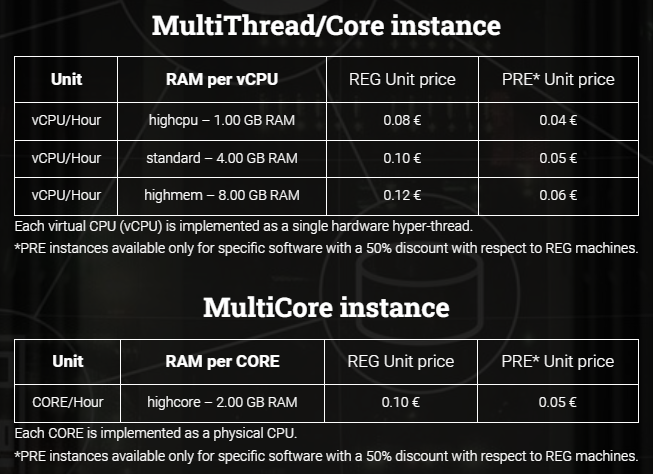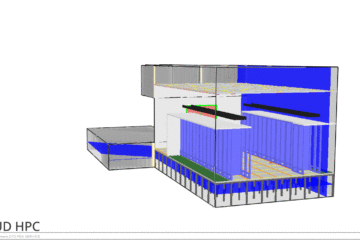CloudHPC – FDS cloud cost
Often users ask how much a simulation on cloudHPC is when using FDS. To this question the reply is generally articulated and this post investigates the main parameters that influences your simulation cost.
cloudHPC pricing
First of all, it is important to remind you how cloudHPC pricing works. Compare to other cloud providers, cloudHPC considers only the vCPU / Hours used while the simulation is running. This means that if your analysis are actually RUNNING you are paying an hourly rate which is proportional to the vCPU you are using for your analysis.
One example: let’s say you are running a 8 vCPU machine with 1 GB of RAM per vCPU (highcpu) on a REG machine. This simulation is going to cost you 0.08 * 8 = 0.64€ per each hour you are running it.

There are two features which make us unique in the cloudHPC providers:
- Each vCPU Hours is calculated only on the effective RUNNING time of your simulation: when the simulation finishes automatically the counter stops.
- There are no other costs involved such as remote storage or data transfer. This makes the simulation costs highly predictable and if there are no simulation running your cost is 0€!
FDS analysis hardware requirements
If you set an FDS analysis you are defining also the hardware requirements the analysis is going to need. The main parameters affecting this are:
- MESH sizes. Each MESH in FDS defines a number of cells in X, Y and Z direction. If you multiply these three number you can get the total number of cells of each MESH. The bigger is the MESH the higher is the hardware resources required to the simulation to complete.
- MESH cells dimension. The mesh affects the simulation requirements not just because of the total number of cells, but also considering the average cell dimensions. Since FDS uses an automatic time step, the smaller the cell dimensions the smaller the time step – this depends on the Courant number applied to your simulation.
- TIME of your analysis. The higher is the T_END of your simulation, the longer it takes to FDS to actually reach it and complete the analysis.
- MODELLING of your analysis. The modelling involved in your analysis can affect the hardware requirements because some models can be more difficult to compute than others. It is difficult to provide a rule of thumb, but it is possible to say that the following elements are usually heavier to compute:
- RADIATION – Radiation is usually heavy to compute. If you are using the RADI namelist and modify the configuration from the default values, you can end up assigning more and more load to your analysis.
- PARTICLES – Computing particles is a heavy task to complete. Sometimes particles are necessaries, but make sure you are reducing their number as much as possible.
- CHEMICAL REACTIONS – FDS can compute chemical reaction and generate smoke and CO considering the parameters SOOT_YIELD and CO_YIELD you set in the REAC namlist. Using this namelist it is also possible to define a user reaction. The computation of a custom reaction is general quite slow as this involves FDS to track each component of the reaction.
- SCALABILITY set-up. In the past, we talked about scalability in FDS. Following instructions provided in those posts or in our guide can really reduce your simulation requirements.
FDS simulation cost
It is impossible to give general rules, so this paragraph may not apply to your situation. On the cloudHPC users generally are able to run FDS simulations on 16 vCPUs (8 physical cores with 2 threads each) and compute between 500s and 1800s every 10 hours. The range is quite wide, but this gives an idea of the costs of the analysis: 12.8€ to compute between 500s and 1800s depending on the configurations mentioned above.
It’s important to stress this is now our lowest rate: it is possible to get two types of discount:
- Using PRE instances you can save 50% of the cost
- Progressive discounts applies you 30% discount on reaching some specific turnover thresholds
This means this cost can be reduced to 4.48€!
CloudHPC is a HPC provider to run engineering simulations on the cloud. CloudHPC provides from 1 to 224 vCPUs for each process in several configuration of HPC infrastructure - both multi-thread and multi-core. Current software ranges includes several CAE, CFD, FEA, FEM software among which OpenFOAM, FDS, Blender and several others.
New users benefit of a FREE trial of 300 vCPU/Hours to be used on the platform in order to test the platform, all each features and verify if it is suitable for their needs




1 Comment
JetFan model in FDS - Cloud HPC · 4 December 2023 at 3:09 pm
[…] dealing with fire preventions systems, CFD software such as FDS allows designers to generate a model for this technical equipments. These models can be easy or […]